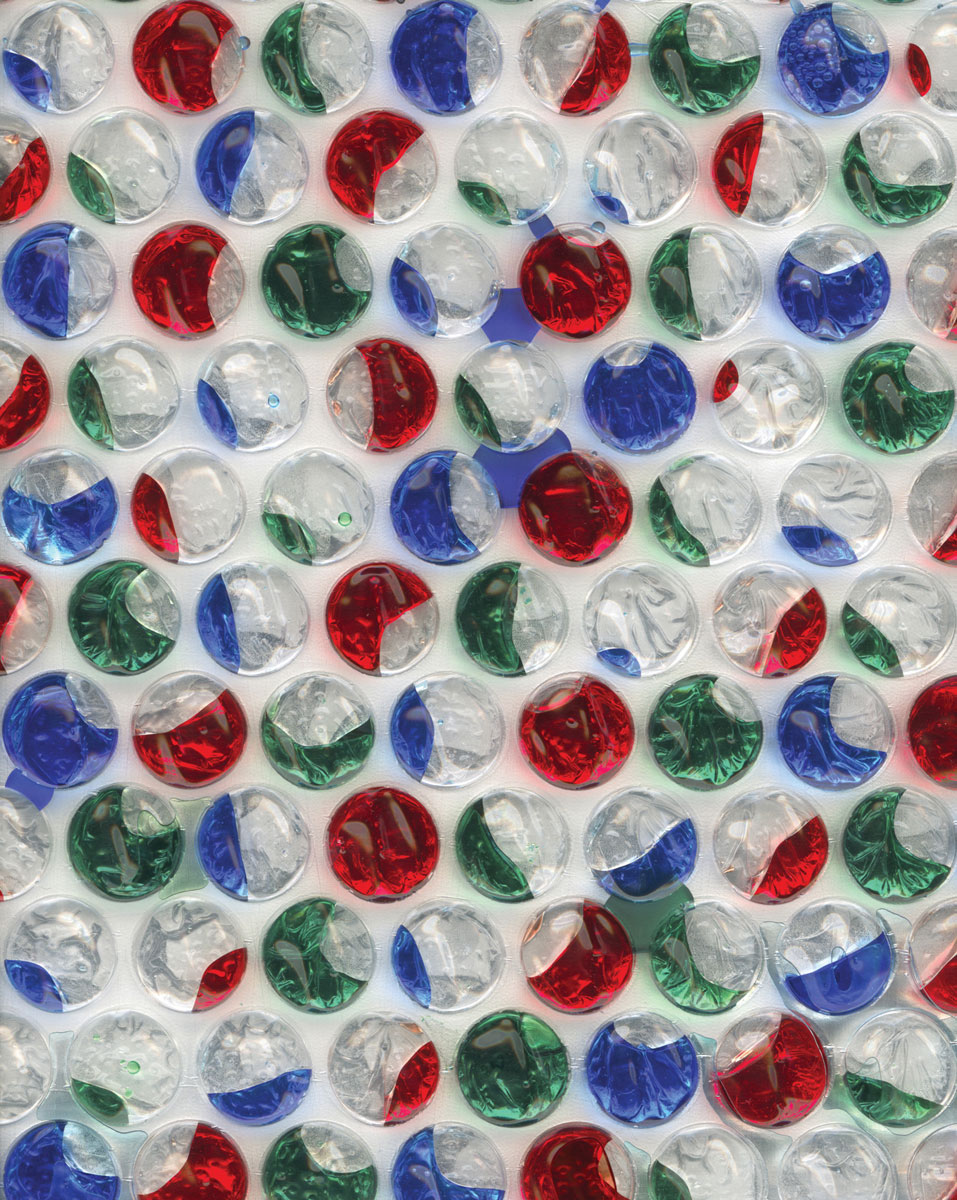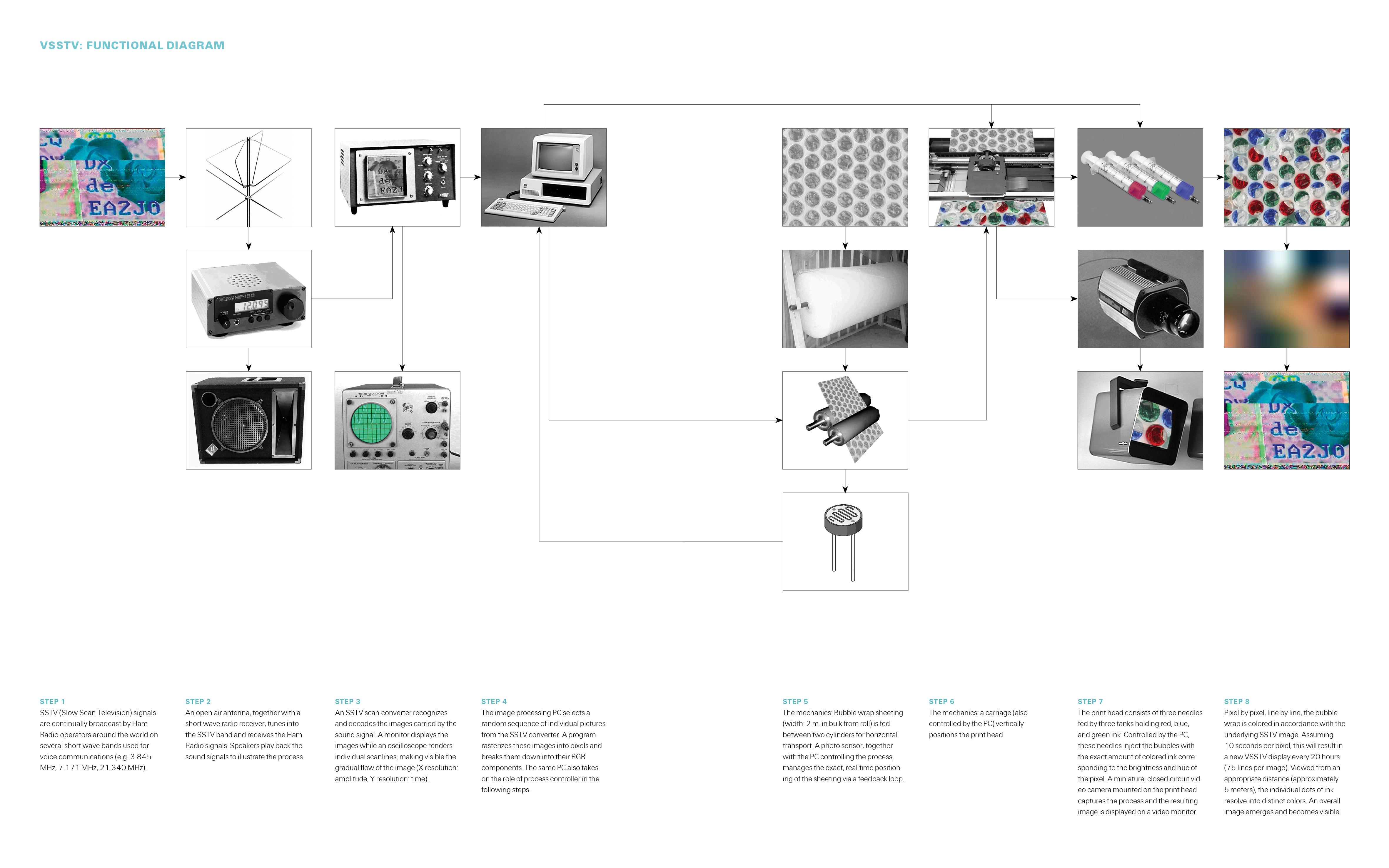Very Slow Scan Television
Tune in, turn on, wait
Gebhard Sengmüller and Jakob Edlbacher

Very Slow Scan Television (VSSTV) is a new television format that we have developed building upon Slow Scan Television (SSTV), an almost 50-year-old image transmission system used by Ham Radio amateurs. In contrast to regular TV, SSTV runs on a dramatically reduced frame rate.
Developed in 1957 by Copthorne Macdonald, Slow Scan Television uses the shortwave radio band (Ham Radio) to transmit television images. Ham Radio not only broadcasts information (as is the case with conventional radio), but also uses the radio spectrum for personal communications, usually on a point-to-point basis over a previously negotiated frequency. In contrast to telephone conversations, this communication is open and can be listened to by anyone who happens to be tuned into the same frequency. The Ham Radio band was reserved for the purpose of voice transmission, and therefore uses only a small amount of bandwidth. Broadcasting images within this narrow bandwidth requires reducing their quality and rules out transmitting moving images. Furthermore, the visual information has to be converted into an audio signal.
According to British Ham Radio operator Guy Clark (N4BM), “The original idea was to find a method of trans mitting a television picture over a single speech channel. This meant that a typical (at that time) 3MHz wide television picture had to be reduced to around 3kHz (1000:1 reduction). It was decided at the outset that the scanning rates must be very slow, which precludes the use of moving pictures. The choice of time base for synchronizing was the readily available domestic power supply at 50 or 60 Hz (depending on the country of origin). This gave a line speed of 16.6Hz and 120 or 128 lines per frame (against the then UK standard of 405 lines (now 625) per frame), giving a new picture frame every 7.2 or 8 seconds. … The original SSTV systems were based on ex-government radar screens and cathode ray tubes with very long persistence (“P7”) phosphors. This allowed an image to be painted on the screen over a period of a few seconds.” The modulation technique often transmits defective images, evident in trapezoid distortions in the image caused by time synchronisation problems.
SSTV may suggest a parallel TV universe, one that developed during an era in which television monopolies were consolidating their hold over mass media culture. But it also shows similarities to current streaming and netcasting technologies where personal flair and taste determine the range of images broadcast. Texts and pictures refer to the location of the sender and his or her identifier. Self-referential features dominate. Guy Clark writes: “What kinds of pictures are sent? Reviewing pictures saved during the last few weeks I found: Hams in their shacks, lots of pet dogs, a frog, kangaroo, astronauts in the Space Shuttle (SSTV has been transmitted from some missions!!!), bridges, birds, Elvis Presley, rock formations, an old-fashioned microphone, antique cars, flowers, children, Jupiter, a cow, someone playing bagpipes, a UFO, many colorful butterflies, boats, and cartoon characters with personalized messages. Even the Russian Space Station MIR has been transmitting SSTV pictures recently!”
VSSTV uses broadcasts from this historic public domain television system—available anytime over freely accessible frequencies—and regular bubble wrap to construct an analogous system in which the packing material functions as the aperture mask. (See below for a technical diagram). Just as a Cathode Ray Tube mixes the three primary colors to create various hues, VSSTV will utilize a plotter-like machine to fill the individual bubbles with one of the three primary CRT colors (red, green, and blue), turning them into pixels on the VSSTV “screen.” Observed from a distance, the clusters of pixels/bubbles will merge into the transmitted image. Large television images will be the result, images that take the idea of slow scan to the extreme. The SSTV format transmits at the rate of up to one frame every eight seconds; in our process, the frame rate decreases to one per day. An observer can witness the extremely slow transformation of the “blank” bubble wrap into an image over the course of 20 hours.
Thanks to Charles Gute and Paul Sengmüller.

Jakob Edlbacher is an industrial designer based in Vienna.
Gebhard Sengmüller is an artist working in the field of media technology, currently based in Vienna, Austria. Since 1992, he has been developing projects and installations focusing on the history of electronic media; creating alternative ordering systems for media content; and constructing autogenerative networks. His main project for the last few years has been VinylVideo, a fake piece of media archeology. See www.gebseng.com/.